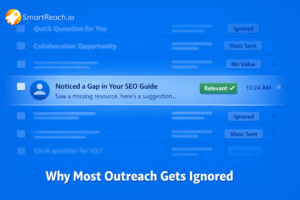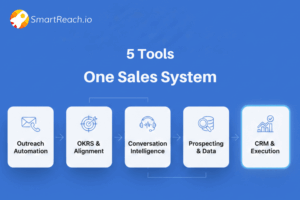Personalize Outreach Messages That Actually Get Responses
You just spent 20 minutes crafting what you thought was the perfect personalized message. You mentioned their recent promotion, referenced their company’s latest product launch, and even complimented their LinkedIn post from last week.
Three days later? Radio silence.
Here’s what probably happened: despite all your research and “personal touches,” your message still felt fake. The recipient could sense it was templated, forced, or worse—manipulative.
If you’re a sales manager or marketing professional doing outreach at scale, this scenario probably sounds familiar. Personalizing outreach content without sounding fake has become one of the biggest challenges in modern sales and marketing. Generic messages get ignored, but over-the-top personalization feels creepy and inauthentic.
If you’re looking for a way to strike the right balance, SmartReach.io makes personalization effortless. Its outreach platform lets you customize emails with dynamic fields, spintax variations, and AI-powered copy suggestions, so every message feels authentic without being over-engineered. You save time, stay consistent, and still sound human.
The good news? There’s a middle ground where personalization feels genuine and drives real results.
Why most personalized outreach fails
Before we dive into solutions, let’s understand why personalization often backfails.
Most people approach personalization like a checklist. They think: “Insert name here, mention their company there, add a compliment about their recent post, and I’m done.” This mechanical approach creates messages that technically include personal details but feel hollow.
Recipients can spot this fake personalization immediately. They’ve seen hundreds of messages that follow the exact same formula.
When personalization feels forced or superficial, it actually works against you, making your message seem less trustworthy than a straightforward, honest approach.
Real personalization isn’t about cramming in as many personal details as possible. It’s about showing genuine understanding of their situation and offering something truly relevant to their needs.
Start by humanizing your content
Before you add a single personal detail, your core message needs to sound human. No amount of customization can fix content riddled with corporate jargon, buzzwords, and robotic language.
Write like you’re talking to a respected colleague over coffee. If your base message feels stiff or formal, all the personalization in the world won’t help.
Here are the elements that make content sound robotic:
- Corporate jargon (“synergies,” “solutions,” “best practices”)
- Overly formal language (“I am writing to inquire about…”)
- Buzzwords that add no meaning (“innovative,” “cutting-edge,” “next-level”)
One tool that helps identify these problem areas is Humanizer Pro. It spots common template traps and suggests more natural alternatives. When you run your content through Humanizer Pro, it helps you find the right words to express your thoughts genuinely.
The goal is creating a conversational tone that feels natural and approachable. If you wouldn’t say it in person, don’t write it in your message.
Weave in names and details naturally
This is where most people stumble. They know they should use the recipient’s name and reference their work, but they do it clumsily.
The secret is being specific and relevant. Instead of generic compliments, reference something concrete that shows you actually paid attention.
Here’s how to weave in personal information effectively:
- Cite specific projects, awards, or articles they’ve published recently
- Explain exactly why you’re reaching out based on this specific detail
- Use their name sparingly—once at the beginning is usually enough
For example, instead of “I saw your recent LinkedIn post and found it interesting,” try “Your point about remote team productivity in last week’s post really resonated, especially the part about asynchronous communication challenges.”
Find and highlight common ground
Shared experiences create instant rapport. This might be a mutual connection, alma mater, industry conference you both attended, or even a hobby you noticed on their social media.
But like other personal details, the reference needs to feel organic. A brief, casual mention usually works better than a full paragraph.
Use common ground to create a friendly foundation for your message. For instance: “I noticed we both attended the Sales Enablement Summit last year—wasn’t Sarah Chen’s presentation on buyer psychology fascinating?”
This approach feels natural because it references a shared experience without forcing it into the conversation.
Focus on value, not flattery
While genuine compliments can work as openers, your outreach shouldn’t rely on flattery alone. Center your message on delivering real value to the reader.
Ask yourself:
- What problem does this solve for them?
- How could this help with a project they’re working on?
- What useful information can I share?
Focus on their needs, not yours. By offering something valuable upfront, you demonstrate that you’re not just taking, you’re giving first.
This approach builds trust and makes people much more likely to respond positively. When recipients see immediate value in your message, they’re naturally more open to continuing the conversation.
Customize your templates wisely
Let’s be honest: if you’re doing outreach at scale, you’re using templates. There’s nothing wrong with that—templates save time and ensure consistency.
The mistake is treating them as unchangeable scripts.
Think of your template as a flexible framework, not a rigid form. A good template includes:
- The basic message structure
- Placeholders for specific personalization
- Room for relevant value propositions
SmartReach.io’s template guide solves this exact challenge. It acts like a starting point to creating a wonderful cold outreach email template. You can create flexible message templates with dynamic fields that automatically pull in prospect-specific information, their name, company, recent achievements, or mutual connections.
This way, each message feels personally crafted while maintaining the efficiency of scaled outreach.
Keep your customized sections brief and conversational. Break longer paragraphs into readable chunks. This makes your message easier to scan and feel less like a mass email.
Track what works and what doesn’t
The best personalization strategy means nothing if you can’t measure its impact. Monitor your open rates, response rates, and conversion metrics to understand which personalization tactics resonate with your audience.
SmartReach.io’s analytics shows you exactly which personalized elements drive the highest engagement. You can A/B test different personalization approaches and see real-time data on what makes prospects respond. This data-driven approach helps you refine your personalization strategy continuously.
Pay attention to patterns. Are messages with industry-specific references performing better? Do prospects respond more to company news mentions or personal achievements? Use this data to guide your personalization priorities.
Respect their time and boundaries
Authentic outreach is respectful outreach. Acknowledge that you’re asking for their time and make it as easy as possible for them to respond, or decline.
Be clear and direct: Get to the point quickly. Explain who you are, why you’re writing, and what you’re asking for.
Avoid pushy language: Don’t be demanding or overly aggressive. One polite follow-up is acceptable, but bombarding someone with messages is a fast track to getting blocked.
Make it easy to say yes or no: Present a clear next step. If you’re requesting a meeting, suggest a specific time frame and include a scheduling link. Most importantly, give them permission to decline.
A simple line like “No worries if this isn’t the right time” shows respect for their autonomy and actually makes people more likely to engage.
Putting it all together
Personalizing outreach is about sounding genuine, not rehearsed. When you keep your tone human, add details naturally, focus on value, and respect boundaries, your messages will feel authentic.
The key is finding the balance between efficiency and authenticity. You can’t hand-craft every single message, but you can create a systematic approach that feels personal.
Tools like SmartReach.io’s multichannel outreach platform help you manage this balance by automating the research and template customization while keeping the human touch that makes personalization effective.
Start by auditing your current outreach messages. Do they pass the “coffee shop test”—would you actually say these things in a casual conversation? If not, it’s time to humanize your approach.
Remember, people want to feel understood, not just targeted. When your personalization comes from genuine interest in helping them solve problems, it stops feeling like a sales tactic and starts building real professional relationships.
FAQs on personalizing cold outreach
Q1. How do you personalize outreach emails without sounding fake?
Personalize by keeping your tone natural, referencing specific details, and focusing on value instead of flattery. Avoid overusing names or forced compliments, and write as if you’re talking to a real person.
Q2. What is the best way to start a personalized outreach message?
Begin with a genuine opener, like mentioning a recent article, project, or shared connection. Keep it simple, specific, and relevant so it feels authentic instead of scripted.
Q3. Why does generic outreach fail?
Generic outreach feels robotic, doesn’t address individual needs, and often ends up ignored or deleted. Personalized outreach shows effort, builds trust, and increases response rates.
Q4. Can you use templates for personalized outreach?
Yes, templates work if customized wisely. Treat them as a framework where you add personal touches like names, achievements, or shared interests, while keeping the message short and conversational.
Q5. What should you avoid in personalized outreach?
Avoid excessive flattery, corporate jargon, and pushy follow-ups. Overusing someone’s name or referencing irrelevant details can also make your message feel fake.
Q6. How does SmartReach help with personalization?
SmartReach.io uses dynamic fields, Spintax variations, and AI-powered suggestions to personalize emails at scale. It ensures your outreach feels human while saving time and improving consistency.



